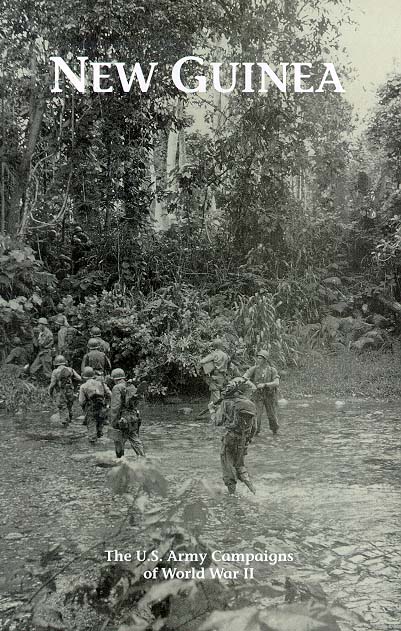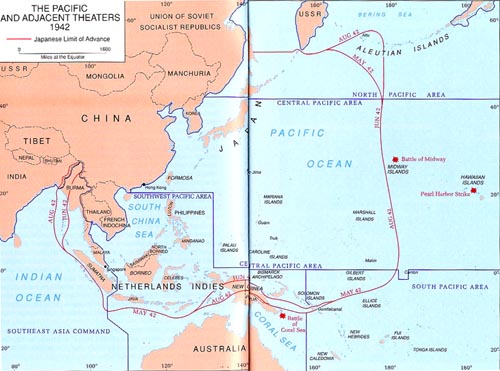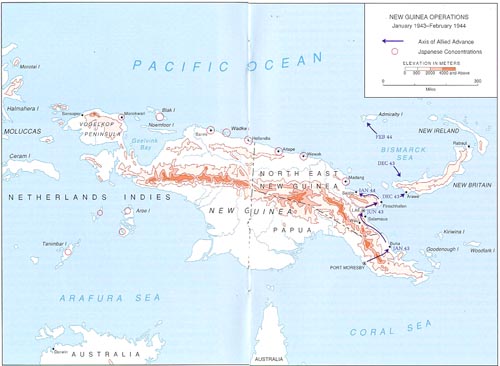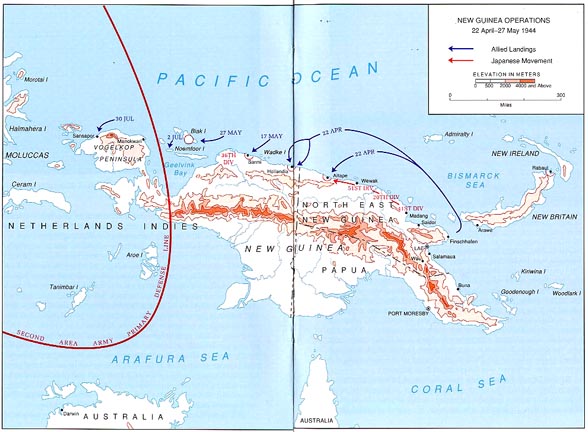World War II was the largest and most violent armed conflict in the history of mankind. However, the half century that now separates us from that conflict has exacted its toll on our collective knowledge. While World War II continues to absorb the interest of military scholars and historians, as well as its veterans, a generation of Americans has grown to maturity largely unaware of the political, social, and military implications of a war that, more than any other, united us as a people with a common purpose.
Highly relevant today, World War II has much to teach us, not only about the profession of arms, but also about military preparedness, global strategy, and combined operations in the coalition war against fascism. During the next several years, the U.S. Army will participate in the nation's 50th anniversary commemoration of World War II. The commemoration will include the publication of various materials to help educate Americans about that war. The works produced will provide great opportunities to learn about and renew pride in an Army that fought so magnificently in what has been called "the mighty endeavor."
World War II was waged on land, on sea, and in the air over several diverse theaters of operation for approximately six years. The following essay is one of a series of campaign studies highlighting those struggles that, with their accompanying suggestions for further reading, are designed to introduce you to one of the Army's significant military feats from that war.
This brochure was prepared in the U.S. Army Center of Military History by Edward J. Drea. I hope this absorbing account of that period will enhance your appreciation of American achievements during World War II.
GORDON R. SULLIVAN
General, United States Army
Chief of Staff
New Guinea24 January 1943-31 December 1944
The campaign on New Guinea is all but forgotten except by those who served there. Battles with names like Tarawa, Saipan, and Iwo Jima overshadow it. Yet Allied operations in New Guinea were essential to the U.S. Navy's drive across the Central Pacific and to the U.S. Army's liberation of the Philippine Islands from Japanese occupation. The remorseless Allied advance along the northern New Guinea coastline toward the Philippines forced the Japanese to divert precious ships, planes, and men who might otherwise have reinforced their crumbling Central Pacific front.
New Guinea is the second largest island in the world. Its north coastline extends nearly 1,600 miles from twelve degrees south latitude to just south of the equator. A major mountain range cuts across the island's center from the eastern end of New Guinea to Geelvink Bay on the west and makes passage overland through the jungled mountains by large units nearly impossible. The lee of the mountainous spine, around the Port Moresby area, is wet from January to April but otherwise dry. On the windward side, scene of most of the ground fighting during 1942-1945, rainfall runs as high as 300 inches per year. As one veteran recalled, "It rains daily for nine months and then the monsoon starts."
Disease thrived on New Guinea. Malaria was the greatest debilitator, but dengue fever, dysentery, scrub typhus, and a host of other tropical sicknesses awaited unwary soldiers in the jungle. Scattered, tiny coastal settlements dotted the flat malarial north coastline, but inland the lush tropical jungle swallowed men and equipment.
The terrain was a commander's nightmare because it fragmented the deployment of large formations. On the north shore a tangled morass of large mangrove swamps slowed overland movement. Monsoon rains of eight or ten inches a day turned torpid streams into impassable rivers. There were no roads or railways, and supply lines were often native tracks, usually a dirt trail a yard or so wide tramped out over the centuries through the jungle growth. Downpours quickly dissolved such footpaths into calf-deep mud that reduced soldiers to exhausted automatons stumbling over the glue-like ground. Fed by the frequent downpours, the lush rain-forest jungle afforded excellent concealment to stubborn defenders and made coordinated overland envelopments nearly
[3]
impossible. Infantrymen carrying sixty pounds of weapons, equipment, and pack staggered along in temperatures reaching the mid-90s with humidity levels to match. Thus the U.S. Army faced a determined Japanese foe on a battleground riddled with disease and whose terrain made a mockery of orthodox military deployments.
Strategic Setting
In January 1943 the Allied and the Japanese forces facing each other on New Guinea were like two battered heavyweights. Round one had gone to the Americans and Australians who had ejected the Japanese from Papua, New Guinea. After three months of unimaginative frontal attacks had overcome a well-entrenched foe, General Douglas MacArthur, the Southwest Pacific Area (SWPA) commander, had his airstrip and staging base at Buna on the north coast. It was expensive real estate. About 13,000 Japanese troops perished during the terrible fighting, but Allied casualties were also heavy; 8,500 men fell in battle (5,698 of them Australians) and 27,000 cases of malaria were reported, mainly because of shortages of medical supplies. Besides ruining the Australian 7th and U.S. 32d Infantry Divisions, the campaign had severely taxed the Australian 5th and U.S. 41st Infantry Divisions. The exhausted Americans needed six months to reconstitute before their next operation. Australian ground forces, despite heavier losses, became the front line of defense against the Japanese who, though bloodied, were ready for round two.
To block the Allied counteroffensives on New Guinea and in the Solomons, Tokyo dispatched thousands of reinforcements to its great bastion at Rabaul, New Britain. On 9 November 1942, Eighth Area Army, commanded by Lt. Gen. Hitoshi Imamura, opened on Rabaul. Eighteenth Army, commanded by Lt. Gen. Hatazo Adachi, was organized the same day and subordinated to Eighth Area Army. Adachi took charge of operations on New Guinea. Despite their defeat at Buna and the heavy losses in the continuing struggle for Guadalcanal, in January 1943 Japan still held the preponderant air, naval, and ground strength in the Southwest Pacific and retained the strategic initiative in New Guinea. With these advantages, they planned to strike again for Port Moresby.
Japanese construction battalions had transformed the prewar airfield and harbor at Lae, North East New Guinea, into a major air base and anchorage on the Huon Gulf. Japanese infantrymen could land at the stronghold and then sortie under air cover to seize a forward air
[4]
base at Wau, located in the malarious Bulolo Valley about 150 miles west-northwest of Buna. With Wau in hand, the Japanese could lunge forward again toward Moresby protected by an aerial umbrella. Isolated and weakly defended, the Australian airstrip at Wau seemed ripe for Eighteenth Army's picking.
In January 1943 Eighth Area Army ordered reinforcements to Lae. Forewarned of the impending convoy by decrypted Japanese naval messages, MacArthur's air chief, Lt. Gen. George C. Kenney, commander of Allied Air Forces and U.S. Fifth Air Force, sent repeated air attacks against the enemy ships. Allied pilots sank two troop transports, damaged another, and killed 600 Japanese soldiers. Only one-third of the intended Japanese reinforcements reached Lae, and these survivors salvaged only half of their equipment. Without reinforcements, the desperate attack on Wau failed. The defeated Japanese remnants fell back into the jungle, slowly giving ground toward Lae.
Repulsed at Wau and pressed by the Australians, Japanese forces on New Guinea urgently needed reinforcements. On 19 February 1943, U.S. Navy cryptanalysts handed MacArthur solid intelligence that the enemy was planning another major transport to Lae in early March. Kenney threw every available aircraft into a three-day struggle from 2 to 5 March, known as the Battle of the Bismarck Sea. Eight transports and four destroyers were lost in all. Of the 51st Division's 6,912 troops, about 3,900 survived, but only 1,000 soaked, oil-stained, and dispirited officers and men reached Lae. Kenney's destruction of the 51st Division condemned the Japanese to the strategic defensive on New Guinea.
From February to June 1943 the battleground in eastern New Guinea lapsed into a stalemate as the opponents reinforced and replaced earlier losses. Shipping shortages created logistics and transportation bottlenecks for both sides. The Imperial Navy could not make good its heavy losses in naval planes and pilots so the Japanese Army Air Force was gradually taking control of air bases and operations in New Guinea. For the Allies, Europe also had first priority, for long-range heavy bombers and fighters were needed in North Africa. Kenney found himself trying to justify additional scarce warplanes from Washington for New Guinea. Carrier-based aircraft in the Pacific remained firmly under U.S. Navy control, as did the greater part of the Pacific Fleet. MacArthur was limited to cruisers, destroyers, and submarines. He lacked transports, cargo vessels, and landing craft as well as the specialized crews to man them. Neither side had the resources in early 1943 to force a decisive victory, and the campaign seemed likely to continue as a war of attrition.
[5]
Operations
At SWPA General Headquarters MacArthur's staff was planning the timetable for his triumphant return to the Philippines. Code-named RENO, it became the basis for operations against Japan from February 1943 through August 1944. During that time, RENO underwent five modifications to keep pace with changing operational and strategic requirements. RENO I envisioned leapfrogging past Japanese strongholds in New Guinea and using paratroopers to seize key bases en route to Mindanao in the southern Philippines. The Japanese roadblock to MacArthur's scheme was the so-called Bismarck Barrier, that is, New Britain and its naval and air bases at Rabaul in combination with the series of Japanese air enclaves dispersed along the northern New Guinea coastline.
The U.S. Joint Chiefs of Staff directive of 28 March 1943 described Southwest Pacific objectives as a line running across the straits between Finschhafen, New Guinea, and New Britain. They ordered MacArthur to establish air bases on Woodlark and Kiriwina Islands; to seize the Huon Peninsula and Madang; and to occupy western New Britain. Meantime, under Admiral William F. Halsey, Jr., Commander in Chief, South Pacific Area, the U.S. Navy with Army and Marine troops would clear the Solomons to southern Bougainville. These operations were seen as preparatory for the ultimate seizure of Rabaul.
From these decisions grew the CARTWHEEL operation, a joint Southwest and South Pacific undertaking that originally envisioned thirteen amphibious operations, over six months, culminating in the capture of Rabaul. It began the night of 29-30 June when Halsey invaded New Georgia, Solomon Islands, and MacArthur struck at Nassau Bay. The following day two U.S, Army separate regiments, the 112th Cavalry and the 158th Infantry, made unopposed landings at Woodlark and Kiriwina respectively.
For CARTWHEEL MacArthur created ALAMO Force, an independent operational command that was in reality almost identical to Southwest Pacific's newly created U.S. Sixth Army. By placing ALAMO Force directly under General Headquarters, MacArthur removed American troops engaged in tactical operations from the control of Allied Land Forces commanded by the Australian General Sir Thomas Blamey. MacArthur personally selected Lt. Gen. Walter Krueger to command Sixth Army. Another American, Vice Adm. Arthur S. Carpender, commanded Allied Naval Forces which included the U.S. Seventh
[8]
Fleet. His aggressive assistant was Rear Adm. Daniel E. Barbey, who commanded VII Amphibious Force, the ships that would carry the ground forces, their equipment, and supplies forward into battle against the Japanese during CARTWHEEL.
The limited sixty-mile range of the boats of the 2d Engineer Special Brigade, selected to transport the troops and equipment, dictated that the 1st Battalion, 162d Infantry, land in Nassau Bay. On 30 June a makeshift fleet of 3 PT boats; 29 landing craft vehicles, personnel (LCVP), and 1 landing craft, mechanized (LCV); and 2 captured Japanese barges carried the battalion to its objective. Although the troops landed without enemy opposition, SWPA had much to learn about amphibious operations. Pounding surf had beached or wrecked eighteen of the precious landing craft. Small bands of enemy soldiers appeared the following day, but after confused nighttime skirmishes in a tropical downpour the outnumbered Japanese fled into the concealment of the thick jungle. They left behind some 50 of their dead comrades as well as 18 dead and 27 wounded Americans.
About forty miles from Lae, Nassau Bay became a staging base that threatened Japanese defenders at Salamaua, a village midway between the two points that guarded the overland approach to Lae. As the 162d Regiment, 41st Division, pushed slowly north along the coast from Nassau Bay, Adachi had to siphon troops from Lae to protect Salamaua. This left his already understrength Lae garrison vulnerable to a flanking attack by sea and air.
An Allied pincer was slowly closing on Lae. While the Americans pushed along the coast, Australian troops advanced on a western axis from Wau through the Markham Valley. The mainstay of the Japanese defense was a lone infantry regiment. In such rugged jungled terrain, however, a few determined men could slow down a division. Numerous streams cut the coastline into a swampy, muddy bog that impeded the American push. The few jungle trails capable of bearing basic logistic support made the direction of the Australian overland thrust predictable. Japanese infantrymen dug in along key terrain dominating the obvious approaches. A grueling 75-day ordeal followed in the jungle wilds under appalling conditions. Patrol-size probes lurching through overgrown and tangled vegetation became the principal maneuver elements. Ambush and sudden death awaited the careless or unlucky because it was often impossible to see more than a few feet into the undergrowth. In the Southwest Pacific, small arms claimed 32 percent of Americans killed in action during the war and artillery 17 percent-a marked contrast to the overall rates in the European theater of 19.7 and 57.5 percent respectively. In part the aberration stemmed from the relative paucity of
[9]
Japanese artillery compared to their Axis allies; in part it reflects the face-to-face combat characteristic of jungle fighting.
American losses from the end of June until 12 September, when Salamaua fell, were 81 killed and 396 wounded while the Australian 15th Brigade suffered 112 killed, 346 wounded, and 12 missing. Japanese losses surpassed 1,000 men. The battle casualties tell only part of the struggle fought out against nature in the jungle wilds. Men on both sides collapsed, exhausted from the debilitating tropical heat and humidity; soldiers shook violently from malarial chills or from a drenching in tropical downpours. Others simply went mad. The neuropsychiatric rate for American soldiers was the highest in the Southwest Pacific theater (43.94 per 1,000 men). The same monotonous field ration-bully beef and biscuits for the Australians, C-rations for the Americans-left soldiers undernourished and susceptible to the uncountable tropical diseases that flourished in the warm, moist jungle.
Japanese losses in their prolonged defense of Salamaua had left Lae exposed to an Allied envelopment. For his part, General Adachi expected the newly organized Fourth Air Army at Wewak to protect Lae's flanks against possible Allied airborne or seaborne assaults. As for MacArthur, the continuing shortage of ships and aircraft in SWPA meant that an envelopment of Lae required a total effort and all available resources. He could not, however, take that risk without local air superiority.
Faced with Japanese air power on two fronts-Rabaul and now Wewak-Kenney concentrated all his might against the latter. Wewak, however, lay beyond the effective range of Allied fighters, and ordering unescorted heavy bombers to make the attack risked unacceptable losses. Instead Kenney built an advance secret air base sixty miles southeast of Lae from where his fighters could reach Wewak. He planned the raid on the basis of compromised Japanese Army Air Force air-ground codes which revealed that the enemy had concentrated ten flying regiments at Wewak. On 17 August 1943, Kenney's airmen struck Wewak and left 100 parked airplanes destroyed on taxiways or damaged in their earthen revetments. A follow-up strike the next morning wrecked 28 more Japanese planes. In just two days Fourth Air Army lost three-quarters of its aircraft. Temporarily crippled, it was unable to oppose the first coordinated airborne and amphibious assault in the Pacific that occurred two weeks later.
More than forty ships manned by 3,200 sailors of Barbey's VII Amphibious Force, with the 2d Engineer Special Brigade attached, carried the Australian 9th Division to landing areas eighteen miles east of Lae. A two-echelon landing spread over 4 to 6 September placed
[10]
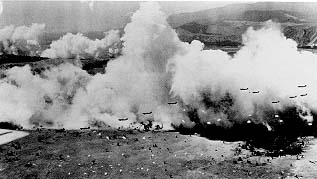
Airdrop at Nadzab, Morning of 5 September 1943.
(U.S.Air Force photograph)
some 7,800 Australian troops in the rear of the Japanese defenses. Meanwhile, unchallenged by Japanese air power, on 5 September 96 C-47 transports, escorted by another 200 fighters and bombers, ferried the 503d Parachute Infantry Regiment to Nadzab, about twenty miles west of Lae. In a spectacular display, hundreds of American paratroopers emptied the C-47s within five minutes. They met no opposition on the ground and quickly secured the landing zone. Within two days C-47s were flying troops from the Australian 7th Division into the airhead. The sea-air envelopment threatened to cut off the 51st Division at Lae from the rest of Eighteenth Army. Adachi ordered the division to withdraw to Finschhafen fifty miles east of Lae. The luckless Japanese had to detour around the Australians blocking the coastal road and into rugged, 12,000-foot-high mountains to reach the north coast. About 8,000 officers and men trekked into the foreboding mountains. More than 2,000 Japanese never came out, most victims of starvation.
Coupled with the loss of the Central Solomons and the Aleutians, this latest reversal convinced Tokyo that its forces were dangerously overextended. Imperial Headquarters therefore established a revised main perimeter line from western New Guinea through the Carolines to the Marianas. Although Rabaul and eastern New Guinea were now expendable, Japanese forces there were ordered to delay MacArthur's advance as long as possible.
[11]
Meanwhile Allied strategy also underwent a major shift. At the QUADRANT Conference held during August 1943 in Quebec, Canada, the Combined Chiefs of Staff approved the Joint Chiefs' recommendation to bypass rather than to capture Rabaul. Now MacArthur's task became the neutralization of the Japanese on New Guinea as far west as Wewak. QUADRANT'S decisions gave priority to the U.S. Navy's drive across the Central Pacific and naturally disappointed MacArthur, who had argued for the seizure of Rabaul. The SWPA commander received official notification of the Combined Chiefs' decisions just five days before his attack on Finschhafen.
Finschhafen was the strongpoint that guarded the western side of the sixty-mile-wide straits separating New Guinea and New Britain. About 3,000 Japanese construction and engineer troops defended from fortified Satelberg Ridge. This high ground overlooked the entire coastline about Finschhafen and blocked any further ground push northward toward Sio. The Japanese perched on the jungle-covered ridgeline waiting for the inevitable Allied landing.
Australian troops arrived at Finschhafen on 22 September. They quickly cleared the narrow coastal enclave encompassing the port and then started up the Satelberg ridgeline. The fighting deteriorated into a series of deadly small unit combats against a well-entrenched and fanatically stubborn opponent. By the end of September 2,400 more men from the 20th Division had reinforced the battle-depleted engineers.
Two weeks later the Japanese launched a combined ground and amphibious counterattack. Australian infantrymen beat back the ground attack, but in the early morning darkness of 17 October one barge full of Japanese troops got ashore on the Allied beachhead. Pvt. Nathan Van Noy, Jr., of the 532d Engineer Boat and Shore Regiment, although seriously wounded by enemy grenades, sprayed the advancing Japanese with .50-caliber machine-gun fire. Van Noy's body was later found with his finger still on the trigger, his last round of ammunition fired, and thirty slain Japanese sprawled in front of his position. He was posthumously awarded the Medal of Honor.
The Japanese counterattack was broken, but they fought on for two more months. Australians of the 9th Division attacked the ridgeline again and again, isolating and destroying pockets of Japanese resistance one at a time. At least 5,500 Japanese perished, but they held their ground until late November. MacArthur found himself bogged down at Finschhafen, where he had expected a walkover.
While the Australians were bearing the majority of the fighting from Nassau Bay to Finschhafen, General Krueger was training his growing number of American divisions to fight as amphibious task
[14]
forces. Admiral Barbey had responsibility for the amphibious portion of the training designed to take full advantage of Southwest Pacific's domination of the air and sea by moving infantrymen over water to strike at their objectives. The seizure of undefended Woodlark and Kiriwina Islands in the southern Solomon Sea about 180 miles east of Buna during June 1943 had served as dress rehearsals for American GHQ planners as well as for lower echelon commanders of combat and service support units.
Southwest Pacific Area had expanded dramatically. From two infantry divisions, the 32d and 41st, in December 1942, the American contingent numbered five divisions (1st Cavalry, 6th, 24th, 32d, and 41st) by 31 January 1944. MacArthur also had three regimental combat teams (formed by attaching a field artillery battalion to the 503d Parachute Infantry, 112th Cavalry, and 158th Infantry Regiments), three engineer special brigades, and five Australian infantry divisions. Three more U.S. infantry divisions-the 31st, 33d, and 43d-were on the way. A combination of organized mosquito control, scientific treatment, and improved malaria discipline drummed into the GIs during training decreased outbreaks of the epidemic sixfold and thus improved combat effectiveness. Kenney had about 1,000 combat aircraft at his command. The new Seventh Fleet commander, Vice Adm. Thomas C. Kinkaid, had about the same number of warships as his predecessor, but Barbey's amphibious fleet had grown with transports, cargo vessels, and landing craft. Together with Admiral Halsey's South Pacific force, the Allied commands enjoyed overwhelming numerical superiority in air and naval strength. They also held the strategic and tactical initiative and could select the times and places for forthcoming operations that were most advantageous to the Allied cause.
The Japanese, in contrast, could not replace their losses in aircraft, shipping, and skilled manpower. Japan's air losses on the New Guinea and Solomons fronts perhaps surpassed 3,000 aircraft. On the ground, Eighteenth Army had suffered around 35,000 casualties. Of the three divisions in eastern New Guinea-the 20th, 41st, and 51st-only the 41st was near full strength. Airfield, shipping, engineer construction, and assorted service units brought Japanese strength in the eastern half of the island to around 60,000 troops. A dangerous 350-mile gap separated maneuver elements of the 41st Division at Wewak from those of the 36th Division at Sarmi, Netherlands New Guinea. The 36th was part of a frenetic Japanese effort to strengthen the western half of the island through the construction of a web of interlocking airdromes. Until the buildup in the west was completed, Imamura and Adachi were locked in a desper-
[15]
ate battle of attrition against a foe with a crushing superiority in resources.
Paradoxically, the jungle that had claimed so many Japanese lives now sheltered them from a concentrated Allied ground offensive. The jungle rendered large unit maneuver impossible so the Allies could not bring their overwhelming firepower, manpower, and material resources to bear en masse against a selected Japanese stronghold. To sustain an infantry regiment in combat devoured the resources of two division equivalents. Every Allied operation depended on an extensive logistics infrastructure, painstakingly scratched out of the wilds, that stretched from engineers developing a coastal enclave and port back through the ships that were the umbilical cord between the advance base and the staging areas. Few soldiers actually fought the Japanese. The majority, perhaps seven of every eight, served in support roles- unloading ships, building roads, hauling supplies, preventing malaria, constructing airfields and bases, and so forth.
How best to use the favorable military balance was a question whose answer depended on where MacArthur decided to go next. CARTWHEEL had scheduled landings by U.S. Marine and U.S. Army units at Cape Gloucester and Gasmata on the New Britain coasts as part of the reconquest of Rabaul. The Quebec decisions, however, meant that MacArthur's staff had to modify the original plan.
MacArthur's intermediate objective was Madang, about halfway between Finschhafen and Wewak. To strike Madang, any Allied amphibious force had to cross the straits separating New Guinea from New Britain. To protect the Allies' flank during the Madang and Cape Gloucester operations, Southwest Pacific headquarters also ordered the seizure of an air and PT base on New Britain. Thus, on 15 December 1943, MacArthur's forces crossed the straits and invaded Arawe on the western tip of New Britain. The 112th Cavalry Regiment tried to surprise the enemy at ,Arawe by a predawn attack in rubber rafts. Although Japanese gunners shot the flimsy boats to pieces and repulsed this diversionary assault, the 112th's main force did get ashore by more conventional means. After suffering through numerous Japanese air raids, the 112th repulsed a Japanese counterattack at the end of the month and eventually pushed the enemy away from its perimeter. Thereafter the cavalrymen, despite the swampy ground and thick mud fed by almost continuous tropical rains, successfully performed every task that the limited nature of their mission allowed. At Cape Gloucester on the north side of New Britain, the 1st Marine Division found itself in similar circumstances, but on a larger scale. Mud, unbroken swamp, and dense jungle made an overland
[16]
advance toward Rabaul impossible. Indeed the increasing tempo of MacArthur's advance rendered it unnecessary.
On New Guinea Australian troops of the 7th Division were ahead of schedule, advancing rapidly through the Ramu Valley on the south side of the Finisterre Range. On the Huon Peninsula the commonwealth's 9th Division had secured Finschhafen in early December and was moving along the coastline north of the range. To exploit the success at Finschhafen, Sixth Army received orders on 17 December to capture Saidor, thereby severing the Japanese line of retreat.
Barbey's VII Amphibious Fleet carried the 126th Infantry Regimental Combat Team (RCT), 32d Division, from Finschhafen through the Dampier Straits 175 miles to Saidor. In contrast to the confusion at Nassau Bay just six months earlier, the unopposed landing at Saidor on 2 January 1944 was a model of precision. Troops and cargo were unloaded in record time, and, at the cost of 6 battle casualties, more than 6,700 troops and their supplies were ashore by evening. MacArthur now had an intermediate staging base for his Madang operation, control of both sides of the straits, and an enemy division trapped at Sio between the Australian 9th Division's steady advance and the 126th RCT's blocking position at Saidor.
Once again the Japanese found themselves forced to flee into the rugged mountains in order to escape encirclement. As they sidestepped inland around Saidor, the retreating Japanese left a trail of abandoned equipment. On 15 January 1944, an Australian patrol pushing through Sio after the fleeing enemy discovered a half-buried trunk in a stream bed. It held the complete cipher library of the Imperial Japanese Army's 20th Division. The find was immediately returned to Central Bureau, MacArthur's Allied cryptanalytic agency in Brisbane, Australia. Central Bureau used the captured code books to solve the Japanese Army's main cipher system. This intelligence windfall arrived exactly when MacArthur was most prepared to take advantage of it.
In January 1944 MacArthur and his staff were searching for ways to accelerate the final phases of the campaign against Madang and complete the isolation of Rabaul. Around this time, Fifth Air Force pilots consistently reported the absence of any signs of Japanese activity on Los Negros, largest of the Admiralty group which lay about 360 miles west of Rabaul. Kenney insisted that air power had driven the Japanese from the island and recommended to MacArthur that ground troops immediately seize the supposedly undefended island with its valuable airstrips. Despite intelligence from decrypted enemy communications which revealed that more than 4,000 Japanese were defending the Admiralties, MacArthur approved Kenney's scheme. On five days'
[17]
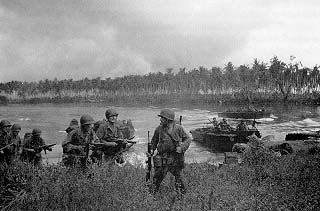
First Wave at Los Negros, Admiralty Islands. (DA photograph)
notice, Sixth Army was ordered to land in the Admiralties. If the troops encountered too much opposition, they would withdraw the same day.
On 29 February 1944, a reconnaissance-in-force of about 1,000 officers and men from the reinforced 5th Cavalry Regiment, 1st Cavalry Division, landed on Los Negros. The initial landings caught the Japanese off guard, facing the opposite direction. But the Japanese fought back with a fury; vicious night fighting typified the next five days. Krueger threw sufficient reinforcements into the battle to tip the balance in the cavalrymen's favor. After three days of piecemeal attacks, the Japanese struck hard on the night of 3-4 March and nearly succeeded in breaking the cavalrymen's lines. During this action Sgt. Troy A. McGill and his eight-man squad withstood repeated attacks. When all but McGill and another man had been killed or wounded, McGill ordered the survivor to the rear, fired his rifle at the advancing Japanese until it jammed, then fought them in front of the position, using the rifle as a club until he was killed. His actions earned him a posthumous Medal of Honor. MacArthur's luck and daring, plus the courage of a handful of cavalrymen like Sergeant McGill, had won an impressive victory.
Capture of the Admiralties isolated Rabaul and gave MacArthur a forward air base that extended his fighter range past Wewak.
Seizing
[18]
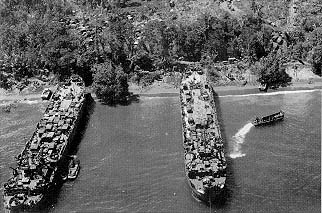
Unloading LST's, Red Beach 2 (Hollandia).(U.S. Navy photograph)
the Admiralties two months ahead of schedule also led the Joint Chiefs to reevaluate Pacific strategy. MacArthur sent his chief of staff, Lt. Gen. Richard K. Sutherland, to Washington to brief an operation remarkable in scope, daring in execution, and promising to cut months off the Southwest Pacific advance. This was the revised RENO IV plan to jump an unprecedented 400 miles up the New Guinea coastline to capture the major Japanese air and supply base at Hollandia. Code-named RECKLESS, the Hollandia operation was a masterpiece of sound planning that took full advantage of extremely accurate intelligence obtained from reading Japanese codes. For MacArthur it proved the decisive operation on New Guinea and was the turning point in his war against the Japanese.
When Allied codebreakers lifted the veil shrouding Japanese defenses, it became evident that MacArthur's next landing, scheduled for 26 April in Hansa Bay, midway between Madang and Wewak, could expect strong ground opposition. Moreover Japanese aerial reinforcements were filling up the major air base complex at Hollandia from where they would support the land defense of Madang. Conversely, Hollandia's land defenses were almost nonexistent. The soft Japanese center remained vulnerable to an Allied landing.
JCS approval of RECKLESS did not automatically ensure success of
[19]
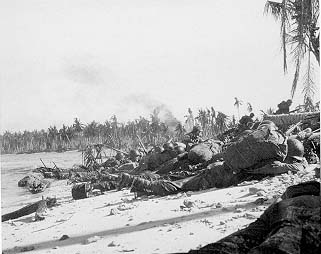
The Assault on Wakde Island.(DA photograph)
execution. MacArthur, for instance, needed carrier air support because Hollandia was far beyond the range of his land-based fighter aircraft. The U.S. Navy, busily preparing for its assault of the Marianas, could provide three days of carrier support and no more. General Headquarters planners then decided to seize Aitape, about 140 miles east of Hollandia. Aitape's airstrips could provide land-based fighter support to the ground troops at Hollandia after the carriers departed. The operation now evolved into a herculean effort by 217 ships to transport safely 80,000 men, their equipment, and supplies 1,000 miles to conduct three separate amphibious landings deep in the enemy rear area. The Japanese fleet was no longer a threat, having withdrawn from Rabaul to the safety of the Philippines. Control of the skies along the invasion route, however, was the prerequisite to success.
By late March, Kenney knew from deciphered Japanese communications that about 350 enemy warplanes were concentrated near Hollandia where they believed themselves safely beyond the range of Allied air strikes. Employing new model P-38s whose extended range
[22]
made them ideal as escorts, Kenney sent sixty B-24 heavy bombers against Hollandia on 30 March. Follow-up raids demolished nearly all the operational Japanese aircraft at Hollandia on the ground. Never again would the enemy contest air superiority over New Guinea.
For MacArthur to bag all of Eighteenth Army, it was imperative that Adachi continue to believe that MacArthur's next blow was aimed at the Madang-Hansa area. A well-designed deception effort fed General Adachi and his staff a steady diet of false information about an Allied landing in Hansa Bay that the Japanese were predisposed to believe. The deception was so successful that on 22 April the 24th and 41st Divisions, led by Lt. Gen. Robert L. Eichelberger, commander of I Corps and the RECKLESS Task Force, landed unopposed twenty-five miles apart at Hollandia. The 163d Regimental Combat Team simultaneously waded ashore against no opposition at Aitape. In one swoop MacArthur had split the Japanese defenses on New Guinea in half, isolating Eighteenth Army in eastern New Guinea.
Once ashore, the 24th and 41st Divisions, moving east and west respectively, conducted a pincer movement to encircle Hollandia's three airfields. The maze of jungle trails, rain-swollen streams, marshy lowlands, and numerous hills and defiles proved a harsher opponent than the Japanese. Although there were 7,600 enemy near Hollandia, most were assigned to service, airfield, and communications units. Only one in ten carried a rifle. Surprised, badly outnumbered, demoralized, and ill equipped for battle, the Japanese fled into the jungle in hopes of reaching Sarmi, about 150 miles to the northwest. On 26 April the pincers closed on the airdromes where GIs discovered an aircraft graveyard of 340 wrecked planes that provided silent testimony to the deadliness of Kenney's earlier air raids.
With the enemy disorganized and confused, MacArthur's strategy was to capture additional forward airfields from which to cover his further advance into Geelvink Bay and thence the Vogelkop Peninsula. While his Sixth Army advanced rapidly westward to exploit his Hollandia advantage by not allowing Japanese defenders any respite, General Krueger simultaneously had to prevent Adachi's Eighteenth Army from breaking through the Hollandia encirclement. Just five days after the Hollandia/Aitape landings, MacArthur ordered the 41st Division to leapfrog to Wakde Island and the airstrips at Sarmi on the adjacent New Guinea coast by mid-May.
The 163d RCT landed unopposed in Maffin Bay near Sarmi on 17 May and prepared to take Wakde. The following day four rifle companies of the 163d assaulted the tiny island. Wakde proved a tough nut to crack. It took two days of nasty squad-size fighting to pry almost 800
[23]
Japanese defenders from their spider holes, coconut log bunkers, and coral caves. In sum, 40 American soldiers were killed and 107 wounded to take Wakde. They counted 759 Japanese corpses and brought back 4 prisoners of war.
By 22 May Krueger had achieved his objectives near Sarmi. He then enlarged the mission. To secure the high ground overlooking Maffin Bay, Krueger ordered an overland advance toward Sarmi village about eighteen miles west of the beachhead. The American push by the 158th RCT ignited a sharp battle for a coral lump overgrown with rain forest, forever after known as Lone Tree Hill. Following several days of close-in fighting, correctly believing itself outnumbered and overextended, the 158th pulled back toward its beachhead.
Three separate Japanese forces threatened the Americans. Units of the 223d and 224th Infantry Regiments had checked the 158th RCT at Lone Tree Hill. Simultaneously a second Japanese task force composed of the main force of the 223d Infantry had infiltrated through the jungle and worked its way behind the strung-out American advance. Yet a third enemy force, a battalion of the 224th Infantry, was returning from the direction of Hollandia, which placed it on the exposed eastern flank of the American beachhead. Fortunately for the GIs, the Japanese could not coordinate their offensive, but their piecemeal attacks alerted Sixth Army to the potential danger of the situation.
Operations farther west required the 158th RCT and the 163d Infantry. To replace them, and to strengthen Army forces, Krueger ordered the entire 6th Infantry Division to the Sarmi region. On 14 June the 6th Division relieved the 158th and took up the fight for Lone Tree Hill. After ten days of tough, close infantry fighting, the now veteran 6th Division held Lone Tree Hill. Division members counted nearly 1,000 Japanese bodies and sealed other enemy soldiers forever in fortified caves. The division itself suffered about 700 battle and 500 nonbattle casualties. With the high ground in American possession, Maffin Bay became a major staging base for all or parts of five different task forces-Biak, Noemfoor, Sansapor, and Leyte, plus Luzon in the Philippines.
The 6th Division was slated to spearhead the Sansapor landing, so Sixth Army headquarters ordered the 31st Infantry Division to Maffin Bay to replace it. From mid-July until the end of August, the 31st conducted aggressive patrolling to keep the Japanese at bay. It suffered about 240 battle casualties while killing nearly 300 Japanese and capturing 14 others before it departed in early September to invade Morotai. The 123d Regimental Combat Team, 33d Division, arrived on 1 September to garrison the area. It remained until January 1945
[24]
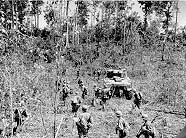
Infantrymen Moving Up, Biak. 1944.(DA photograph)
when a battalion combat team of the 93d Infantry Division replaced it. Altogether the fighting near Sarmi cost U.S. Army units approximately 2,100 battle casualties. Five times that number of Japanese perished. Although the area later supported five invasions, the push toward Sarmi was a significant distraction at a time when Krueger had his hands full juggling four other major operations-Aitape, Noemfoor, Sansapor, and Biak.
Biak Island dominates strategic Geelvink Bay. Its coral airstrips, suitable for heavy bombers, were a powerful lure to MacArthur and Kenney. On 27 May the 41st Division (minus) arrived at Biak which lies only sixty miles south of the equator. The first wave landed exactly as planned, but strong currents carried subsequent units well west of their designated landing beaches. There was, fortunately, only nominal enemy resistance because the invasion caught the Japanese garrison flat-footed. Still, the steaming equatorial heat, thick, twelve-foot-high scrub growth, rugged terrain, and small parties of Japanese entrenched in caves cut into the face of a 200-foot-high cliff combined to slow the American advance along the coastal track toward the vital airstrips. Nevertheless, by the following morning, patrols of the 162d Infantry Regiment were within 200 yards of the island's airfields. Then a violent Japanese counterattack drove them back.
American troops now found themselves under attack from the west and the targets of well-aimed fire from the East Caves which dominated the coastal road. In constant danger of being cut off, the 162d fought an unseen enemy until ordered to withdraw in late afternoon. The next morning opened with another counterattack by the 222d Infantry Regiment supported by half a dozen light tanks. Sherman M4 tanks dispatched the inferior Japanese models while the 162d broke the infantry attack. The Japanese, however, regrouped for
[25]
another attack. More importantly, the Americans finally recognized the importance of clearing the high ground of Japanese.
In these circumstances, the 41st Division commander, Maj. Gen. Horace H. Fuller, requested reinforcements. Krueger dispatched the 163d RCT, which had accomplished its mission at Wakde and was an organic regiment of the division. It arrived on 1 June along with an admonition from Krueger to the division commander to push the offensive vigorously. Meanwhile the 186th Infantry Regiment had occupied the plateau overlooking the landing beaches and was pushing westward. With the 162d along the coastal road pinning the Japanese defenders, the 186th threatened the East Caves from the rear. MacArthur, however, wanted the airfields immediately to support planned landings farther west. His unrelenting pressure on Krueger translated, in turn, to Krueger's demands that the 41st Division quickly take the airfields. Thus the 186th Infantry was ordered from the high ground down to the airfield on the coast. By moving into this basin, the regiment placed itself under Japanese guns and suffered a continual pounding. Because the enemy dominated the airdrome by fire, it remained unusable by Allied warplanes.
MacArthur then dispatched General Eichelberger to the island with orders to get the troops moving on the airfield. Despite a shakeup of commanders, the fighting continued unabated on Biak through June, and the island was not completely secured until mid-July. The doomed garrison fought tenaciously, but to a foregone conclusion that left more than 4,800 Japanese dead at the cost of nearly 2,800 American casualties. Because Biak's airfields were not taken as scheduled, MacArthur ordered the capture of the strips on tiny, 15-mile-long by 12-mile-wide, Noemfoor Island situated 60 miles west of Biak.
Preceded by an intense naval bombardment, more than 13,500 troops of the 158th Regimental Combat Team (Reinforced) stormed ashore on Noemfoor on 2 July against desultory resistance. One dazed Japanese prisoner announced that recently arrived reinforcements had raised the garrison's strength to nearly 4,500 men. The surprised task force commander immediately requested reinforcements from Sixth Army. In truth no Japanese reinforcements had landed on Noemfoor, but the reserve of 1,500 officers and men of the 503d Parachute Infantry Regiment jumped onto the island using its runway as their drop zone. High winds carried the parachutists to bone-cracking landings in supply dumps, vehicle parks, and amidst wrecked Japanese aircraft. No paratroopers fell to hostile fire, but 128 were injured in the jump, including 59 serious fracture cases.
To the paratroopers also fell the nasty job of mopping up the
[26]
enemy on Noemfoor. "Mopping up" meant searching for an elusive enemy and hoping you found him before he found you. When the Japanese did surprise a platoon from the 503d, Sgt. Ray E. Eubanks led his squad to their relief. Enemy fire wounded Eubanks and smashed his rifle, yet he continued to lead his men forward and, using his rifle as a club, killed four Japanese before he was again hit and killed. His heroism earned a Medal of Honor. For the entire Noemfoor campaign, the task force incurred a total of 411 battle casualties while killing 1,759 Japanese and capturing another 889, mostly laborers. While GIs secured Biak and Noemfoor, 500 miles to the east Eighteenth Army was approaching Aitape.
After scant opposition following the 22 April landing at Aitape, Allied engineers had quickly converted the existing Japanese airdromes into a major fighter base. By early June the 32d Division had established an outer defensive perimeter along the western banks of the Driniumor River, about fifteen miles east of the airstrips. Extensive intelligence reports warned the American commanders of the coming offensive.
Privy to the unfolding enemy plan thanks to codebreaking, Krueger asked MacArthur for, and received, additional infantry, artillery, and air reinforcements for Aitape, bringing the total forces, either present or en route, to two and two-thirds divisions. Eventually the 32d and 43d Infantry Divisions, plus the 124th Infantry, 31st Division, and the 112th RCT as well as a corps artillery section and tank destroyer battalion stiffened the defense. On 28 June Krueger created XI Corps to oversee the growing Allied force and appointed Maj. Gen. Charles P. Hall its commander. Hall enclosed the vital airstrips with a semicircular, ten-mile, defensive belt whose flanks rested on the sea. Along this line were more than 1,500 mutually protective log bunkers. Barbed wire obstacles and entanglements girded the line. Within that perimeter stood the equivalent of two divisions, including nine infantry battalions. Fifteen miles east, however, only three infantry battalions and two understrength cavalry squadrons defended the Driniumor River line. They had little barbed wire, few bunkers, poor fields of fire, and miserable jungle tracks for communication.
The Driniumor's twenty-foot-wide stream was easily fordable, calf-deep water. Dense jungle and towering trees on both sides of the wider riverbed effectively masked movement on the opposite banks. American riflemen and machine gunners in foxholes, pits, and a few bunkers along the river nervously awaited a Japanese attack. Japanese prisoners of war told of a forthcoming assault. American patrols had encountered stiffening Japanese resistance, and numerous decrypted
[27]
messages pointed to an imminent offensive. Rather than wait for the Japanese attack, Hall ordered a textbook maneuver, a reconnaissance-in-force along both enemy flanks, to commence on 10 July.
That morning an infantry battalion on the north and a cavalry squadron on the south crossed the Driniumor and probed cautiously eastward. The reconnaissance-in-force passed north and south of Eighteenth Army's main assembly areas which were from two to four miles inland from the coast. Only two infantry battalions and a cavalry squadron remained to defend the Driniumor line.
That night ten thousand howling Japanese troops burst across the shallow Driniumor and charged through the center of the badly outnumbered and undermanned covering force. GIs fired their machine guns and automatic rifles until the barrels turned red hot, but the Japanese, eerily visible under the light of flares, surged forward. American artillery fell in clusters on the Japanese infantrymen, killing and maiming hundreds or crushing others beneath the tall trees that snapped apart in the unceasing explosions. Japanese numbers proved irresistible. Their breakthrough precipitated a month-long battle of attrition in the New Guinea wilds.
GIs moved behind heavy artillery support to close off pockets of Japanese resistance. The jungle restricted movement so the hardest fighting fell to rifle squads or platoons. Infantrymen fought a disconnected series of vicious actions that appeared coherent only on headquarters' situation maps. Adachi's men asked no quarter and received none. During July and August 1944, nearly 10,000 Japanese perished. Almost 3,000 Americans fell along the Driniumor, 440 of them killed. In terms of American casualties, it was MacArthur's most costly campaign since Buna.
One measure of the severity of the fighting was the award of four Medals of Honor, all posthumously, for the campaign. Three soldiers received the decoration for self-sacrifice. Pvt. Donald R. Lobaugh of the 127th Infantry, 32d Division, launched a single-handed attack on a Japanese machine gun nest that saved his squad but cost him his life. S. Sgt. Gerald L. Endl, 128th Infantry, 32d Division, also single-handedly engaged the enemy at close range to save seven wounded Americans. As Endl was carrying the last wounded man to safety, a burst of Japanese machine gun fire killed him. Second Lt. George W. G. Boyce, Jr., of Troop A, 112th RCT, threw himself on a hand grenade to save his men. Second Lt. Dale Eldon Christensen, also of Troop A, won the medal for his series of heroic actions and outstanding leadership during the 112th's mid-July counterattack. Christensen was later killed "mopping up" after a Japanese attack. Their valor and
[28]
the anonymous heroism of their comrades broke the back of Eighteenth Army.
Hall's victory allowed Sixth Army's other ongoing operations to proceed on or ahead of schedule and validated MacArthur's concept of bypassing the enemy. Adachi's terrible defeat left Eighteenth Army trapped between the Americans in the west and the Australians in the east. In mid-December 1944 Australian forces began a slow, determined drive from the east toward Wewak, which finally fell on 10 May 1945. Australian losses were 451 killed, 1,163 wounded, and 3 missing. Some 7,200 Japanese fell. Adachithen kept his approximately 13,000 survivors together in the hills and surrendered only in September 1945. Adachi himself was tried at Rabaul for war crimes, but beat the hangman by committing suicide in September 1947.
>With the fighting along the Driniumor flickering out, MacArthur's final assault landing on New Guinea took place at Sansapor, a weak point between two known Japanese strongholds on the Vogelkop Peninsula. There were about 15,000 Japanese troops of the 35th Division at Manokwari, 120 miles east of Sansapor. Sixty miles to Sansapor's west were 12,500 enemy soldiers at the major air base complex of Sorong. Rather than fight on the enemy's terms, MacArthur employed SWPA's well-tested amphibious capability to leapfrog to Sansapor where, on 30 July, 7,300 men of the 6th Division conducted an unopposed landing. Sixth Army had once again split the Japanese forces in order to seize a coastal enclave that combat engineers quickly transformed from jungle overgrowth into two airfields that provided valuable support during MacArthur's invasion of Morotai in the Molucca chain. Japan's 35th Division found itself isolated in western New Guinea. For historical purposes, Sixth Army closed the Vogelkop operation on 31 August 1944, although the 6th Division remained there until it left for Luzon, Philippines, in January 1945. Units of the 93d Infantry Division then took over the defense of the airfields.
Analysis
The New Guinea Campaign is really the story of two Allied armies fighting two kinds of war-one of grinding attrition and one of classic maneuver. During the attrition period, from January 1943 until January 1944, Australian infantrymen carried the bulk of ground combat while the Americans reconstituted, reinforced, and readied themselves for the maneuver phase of the campaign. During attrition warfare characteristic of eastern New Guinea ground operations through the seizure of the Saidor in January 1944, the Allies suffered more
[29]
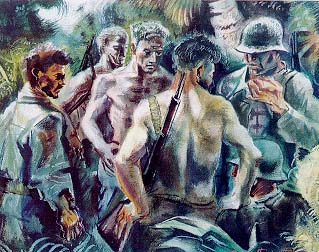
Jungle Fighters, Arawe, Pacific, by David
Fredenthal.(Army Art Collection)
than 24,000 battle casualties; about 70 percent (17,107) were Australians. All this to advance the front line 300 miles in 20 months. But following the decisive Hollandia, Netherlands New Guinea, envelopment in April 1944, losses were 9,500 battle casualties, mainly American, to leap 1,300 miles in just 100 days and complete the reconquest of the great island.
The series of breathtaking landings, often within a few weeks of one another, were the fruits of the Australians' gallant effort in eastern New Guinea. They fought the Japanese to a standstill at Wau and then pushed a fanatical foe back to the Huon Peninsula. This gave Sixth Army the time to train and to prepare American forces for the amphibious assaults that MacArthur envisioned. It also bought the time to bring the industrial capacity of America to bear in the Southwest Pacific. Aircraft, ships, landing craft, ammunition, medicine, equipment-in short, the sinews of war-gradually found their way to MacArthur's fighting men. Still, without flexible senior commanders who adapted their plans to wring full advantage of Japanese weakness, the campaign could have degenerated into a meatgrinder
[30]
along the coast which is what the enemy wanted.
Instead the speed of MacArthur's seaborne envelopments consistently surprised the Japanese. At the strongpoints where they expected to fight a delaying action, MacArthur bypassed them. Where they were weak, he overwhelmed them. Between Wau and Sansapor 110,000 of the emperor's soldiers and sailors died from enemy action, disease, or starvation in the pestilent jungles, the cold mountains, or in the empty seas. Another 30,000 were isolated in New Guinea and neutralized. Add to this the more than 57,000 imperial soldiers and 39,000 sailors marooned on New Britain and the totality of Allied victory in the New Guinea Campaign comes into sharp relief.
Victory on the ground depended on local air superiority which enabled the Navy to carry the ground forces safely forward to the next objective. The infantry held the ground and allowed the engineers to construct a forward air base, and the cycle began again. Against this sophisticated employment of combined arms warfare, modern technology, and industrial might, Tokyo asked its hardened veterans to do the impossible. Japanese infantry operations, brave, determined, but futile, were swept aside by Allied joint operations relying on the combined air, naval, and ground firepower essential for the conduct of modern war. MacArthur bypassed the jungle and left it to devour the Japanese soldiers isolated in its interior.
But above all New Guinea was the story of the courage of the GI who could always be counted on to move forward against a determined foe. It was the ordinary American soldier who endured the worst deprivations that the debilitating New Guinea climate and terrain could offer. It was the lowly GI who was the brains, the muscle, the blood, and the heart and soul of the great army that came of age in the Southwest Pacific Area in 1943 and 1944. In one tough fight after another, he never lost a battle to the Japanese. Those accomplishments and sacrifices are forever his and deserve to be remembered by all.
[31]

Further Readings
Two volumes of the U.S. Army in World War II series, John Miller, Jr., CARTWHEEL: The Reduction of Rabaul (1959) and Robert Ross Smith, The Approach to the Philippines (1953) remain the best accounts of the New Guinea Campaign. Similarly David Dexter, Australia in the War of 1939-45: The Army: The New Guinea Offensives (1961) is an excellent recounting of Australia's ground war on New Guinea. Several top American commanders like Robert L. Eichelberger and Milton MacKaye, Our Jungle Road to Tokyo (1950); Walter Krueger, From Down Under to Nippon (1953); and George C. Kenney, General Kenney Reports (1949) discuss New Guinea operations in general terms. More critical, though still general, accounts appear in Eichelberger's letters published in Jay Luvaas, ea., Dear Miss Em (1972) and D. Clayton James' excellent biography The Years of MacArthur, vol. 2,1941-1945. Edward J. Drea's "Defending the Driniumor," Leavenworth Paper No. 9 (1984) details tactical operations at Aitape while his MacArthur's ULTRA: Codebreaking and the War Against Japan, 1942-1945 (1992) analyzes MacArthur's use of intelligence during the New Guinea fighting.
CMH Pub 72-9
Cover: Troops of the 32d Division near Saidor.(DA photograph)
